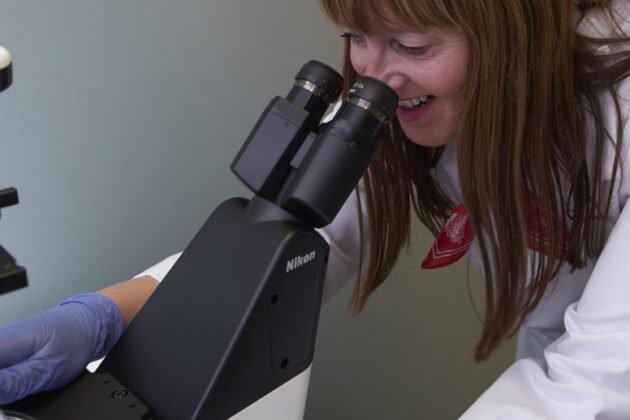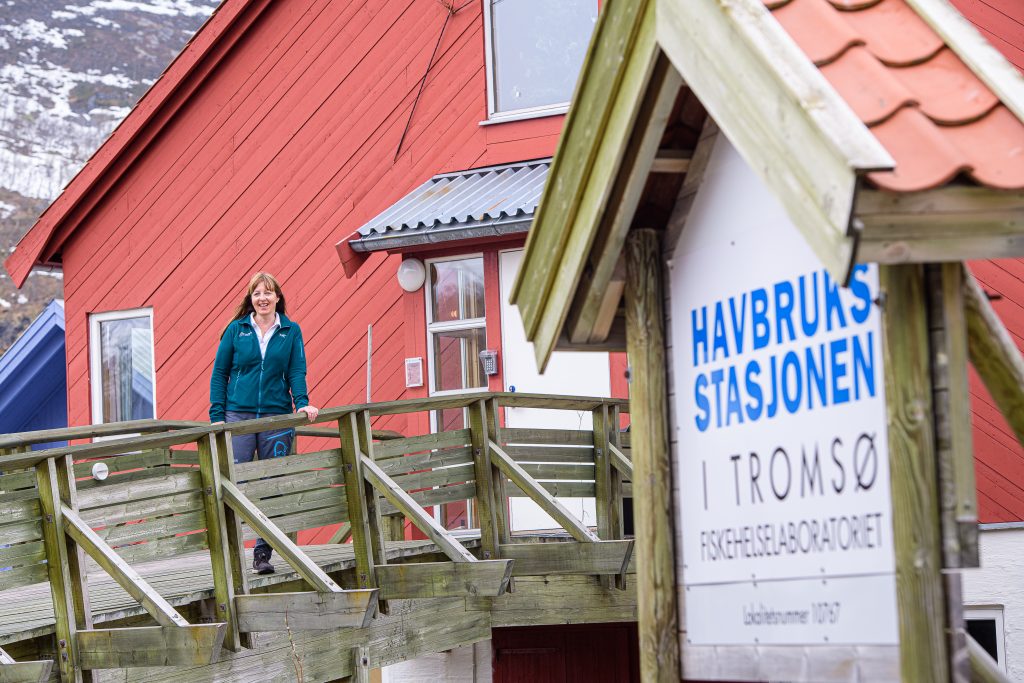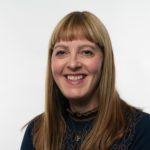Mette – a scientist with a passion for parasites

Many are really, really small. Some are so tiny that they cannot even be seen with the naked eye. But they all require consideration and attention from scientist Mette Serine Wesmajervi Breiland at certain times.
Facts
Name: Mette Serine Wesmajervi Breiland
Age: 47
Education: Master of Science in Microbiology from the Norwegian College of Fishery Science (1997)
Worked at Nofima: 18 years
We are talking about amoeba. These are single-cell organisms that, in large quantities, can cause disease and suffering for, among others, salmon at fish farms. This can entail large economic losses and additional work for salmon farmers.
Now we are talking about lice. The eternal bane of salmon farmers, which they spend millions of Norwegian kroner on each year, as they try out numerous methods to eliminate the lice with minimal suffering on the part of the salmon.
But there are also other virulent pathogenic organisms that are present in Norwegian fish farming.
While others may talk about these tiny nuisances with disdain, Mette Breiland refers to her “little rascals” with something that is close to love and compassion.
“Parasites are my area of interest. When it comes to amoeba, my job is to make them thrive and multiply in the laboratory. This is so that we can use them later in infection trials, thereby contributing to the elimination of disease in farmed salmon” the Nofima Scientist says.
When scientists have control of the parasite itself, the course of the disease and what it does to the fish, they are subsequently able to test both preventive measures and various treatment strategies.
“This is a crucial tool in my everyday working life,” Mette Breiland says.

Applied scientist
As a scientist at an applied institute, Mette Breiland spends much of her time conducting research assignments commissioned by parties from industry. Such work could include understanding how the feared amoeba gill disease, or AGD, attacks fish and how it can be treated. In order to understand this, some fish have to be infected with the disease so that it is possible to research a cure by testing out various strategies on sick fish.
“We infect a limited number of fish under controlled conditions to subsequently administer treatment using e.g. peracetic acid, which is one project we are working on. It should kill the disease but ideally not cause too much strain for the fish. We have to test and identify the correct treatment agent, the correct amount and the correct treatment time,” says Mette Breiland.
She considers herself to be a typical applied scientist. Rather than publishing groundbreaking scientific papers, she writes a large number of confidential reports to industry figures and the companies that commission and pay for the trials. These could be large or small players who have great ideas and suggestions for resolving relevant disease issues.
In addition, Mette’s work on the maintenance of various infection models is also important to research colleagues – both within and outside of Nofima – who work at a more fundamental level to understand how fish respond to various parasites, bacteria and viruses.
“I feel a great sense of responsibility towards our customers, who spend large amounts of money on attempting to solve challenges in salmon farming and who put their faith in us as an institute and me as a research scientist to be able to provide them with answers to resolve these issues,” Breiland says.
A lot of time is spent on research planning internally at Nofima as well as on the implementation of the research itself. Everything has to be planned down to the smallest detail and the Havbruksstasjonen aquaculture station in Tromsø is an important contributing factor in these assignments.
“The positive collaboration I have with them is crucial to my working life and for me to succeed at what I do. Naturally, there is also plenty of communication with customers to ensure that they are informed of the current status and how things are progressing at all times. It is important to have a good dialogue in place with those who invest time and money in our collaboration.”
Infection models

Infection models are necessary tools for Mette’s work as a research scientist in fish health. To the greatest extent possible, models must mimic the actual infections that take place at a fish farm so that the measures that are developed have an effect. Firstly, she familiarises herself with the parasite or bacteria she will be using. This involves a lot of laboratory testing with cultivation, growth and reproduction, etc.
“When we have achieved complete control at all stages, the model is ready for use in the testing of new feed or new treatment agents, or as preventive or treating strategies. The fact that we are already intimately familiar with the course of disease allows us to know whether or not the strategy is working,” the scientist explains.
“I am involved in a few large but also a number of smaller projects. My office looks like a patchwork quilt,” Mette Breiland laughs.
The client owns the results she and her colleagues arrive at through commissioned research.
But the Nofima scientist hopes and believes that industry parties share their results and experiences from collaborations with Nofima so that more can benefit.
“No-one benefits from being secretive about the outcomes but everyone benefits from important results being published so that more people can benefit from it,” she says.
For her own part, she feels that the contact she has with various industry parties allows her to develop in several directions, both in the form of increased general experience and in relation to the planning and implementation of research.
“This is useful in new assignments, as it could make future projects even more efficient. What are considered key issues for industry are also reflected by who gets in touch with us to collaborate and what they are seeking to solve,” Mette Breiland says.
Welfare is central
The welfare of fish in research is central to everything that Mette does – at the laboratory at Nofima’s headquarters in Tromsø and at the research cells at the aquaculture station in Kårvika outside Tromsø.
She also spends a significant amount of time writing applications to the Norwegian Food Safety Authority for permission to conduct the various trials. Each trial has to be described and documented to the smallest detail, including everything that will be done to individual fish.
“It is important to me that the trials are carried out correctly and that they are as well documented as possible. Safeguarding the health and welfare of research fish is something we are acutely aware of when we carry out research and fish trials. We constantly strive to ensure that the trials cause the least amount of distress possible to individual fish. So when we spend so much time planning and describing trials, it is not because we are jumping through hoops for the Norwegian Food Safety Authority to get permission to conduct the trials, but because we actually want the fish to have the best possible experience,” Mette Breiland says soberly.
Nevertheless: Some research fish die from disease during trials. The focus is on ensuring that their suffering is as minimal and brief as possible.
“We conduct these trials on relatively few specimens so that the vast majority of farmed fish can avoid disease and suffering. Everything we do is done to help the industry towards getting rid of a disease problem,” the scientist says.
Never monotonous

Today, the investigation of the course of disease in salmon infected with AGD is on the agenda. Five fish of around 170 grams each are removed from the tank, where the remaining 95 of the species are left to swim around seemingly without any problems. A bucket is filled with seawater with added anaesthetic, helping the salmon to get calm enough for their gills to be examined quickly and efficiently. Have the amoeba raised by Mette in the lab been strong and plentiful enough to cause disease? Has the disease infected any of the 100 research fish? And if so, how far has it advanced after one week?
There is a gill score from 0-5 that provides some indication of how advanced the disease is. After examination, the scientist concludes that there are signs of disease in the fish but that it has far from struck with full force as of yet. So far, the score is between 0 and 1, but this is not unexpected one week after infection. There would be no purpose in initiating any treatment for the disease just yet.
And when all five of the anaesthetised fish are awake and in full vigour in the tank again there is an extremely satisfied scientist packing up and writing the necessary notes before heading back to the office in Tromsø.

“I enjoy this balance in my work life: Some time at the office, some time at the lab and some time at the trial cells. This ensures that things are never monotonous.”
In order to infect the fish with a disease, the scientist needs to have access to the source of infection. For this reason, Mette spends a fair amount of time at the lab together with, among others, “her” amoeba. Isolates of specific amoeba types are supplied from the Norwegian Veterinary Institute, with which she has a positive collaboration, but it is the Nofima scientist’s responsibility to take care of them in the quantities required to be able to conduct trials.
Bacteria and viruses can be frozen until they are needed. Amoeba have to be kept alive continuously and multiply at the lab in order to be useful.
“My task is make sure the little rascals thrive,” she says drily.
Know your amoeba
The amoeba live in cultivation vessels in a well-adapted cultivation medium. They require seawater with a high salt content to thrive and survive. This is how they are cultivated at the lab in order to be used in infection trials at any time.

“It is important to know your amoeba well at all times. We need to know that we are dealing with the type we want to be dealing with. The challenge can actually be in infecting the fish. I have to take great care of the amoeba so that they grow and multiply in a short period of time. It is also crucial that they are virulent – i.e. infectious – for the fish to develop disease. If they lose their virulence, which can happen after a prolonged period of laboratory cultivation, the fish will not become infected. And then we are in trouble,” the scientist says.
She follows the growth of the amoeba over time using a microscope and is able to tell when it is necessary to split them into new cultures.
”At the lab we also use the microscope to simply count how many amoeba there are per millilitre of liquid. Based on this, we are able to calculate how many millilitres are required to infect a given number of fish,” explains Mette Breiland.
And when the amoeba or salmon lice have played their part, they are destroyed under high pressure in an autoclave at the laboratory. Nothing is poured down the sink or thrown directly into the rubbish.
“This also has to be carefully documented,” says the applied scientist.
Climate change and the fact that AGD thrives at higher sea temperatures is something she feels necessitates continued research in the area.
“The disease is likely to creep further north in line with the sea temperature rising in coming years. It would therefore be in everyone’s interest to safeguard fish health and have multiple parties working to succeed. This gives cause for optimism,” says Mette Breiland.

Contact person
Research areas
Farmed fish
Topics
Fish health
